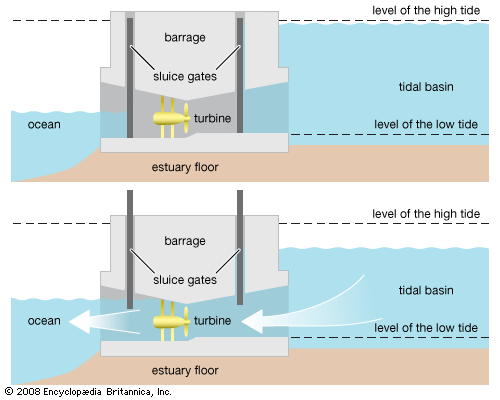Tidal Energy Friends
Join to do a better world
What's the tidal energy?
Tidal energy is energy that takes advantage of the rise and fall of sea water produced by the relative position of the earth and moon and results from the attraction of the latter and sun on the masses of the waters of the seas. It is a renewable energy source.
Operation of tidal energy
History of the tidal energy
The first tidal power plants using natural sea basins to build dams to let it fill with water containing high tide as the tide went out. Then let flow through a waterwheel. The energy obtained was generally used to grind wheat available about 2 or 3 hours.
The first tidal power plant was built in La Rance River (France) in 1967.
La Rance River (France)

La Rance River (France)

Tidal power stations
The tidal power stations can be classified into two types: Central tidal turbines and tidal barriers stations.
In tidal turbines plants the scientists think that it would be the principal method to transform the tidal energy.
advantages and disadvantages
5.1. Tidal turbines plants
This idea emerged thanks to the electric motor generator propellers for underwater vehicles. Instead of using electricity to initiate movement of the propeller and drive the vehicle, the water flow turns the propellers generating electricity. It works the same way that wind farms and costs the same as them. This generation has many advantages over the other methods.
advantages and disadvantages
5.1. Tidal turbines plants
This idea emerged thanks to the electric motor generator propellers for underwater vehicles. Instead of using electricity to initiate movement of the propeller and drive the vehicle, the water flow turns the propellers generating electricity. It works the same way that wind farms and costs the same as them. This generation has many advantages over the other methods.
5.2. Barriers plants tidal
They are barriers constructed across an estuary or bay that must support a range of special tide. The range should exceed 5 meters to be useful. The barriers has gates that open the way to the water. The gates are closed when the tide has stopped rising, trapping water in the basin. As the tide recedes outside the barrier, the barrier gates containing turbines are opened and the difference of water levels inside and outside the barrier caused to flow through these gates, powering the turbines and generating energy.
Current projects
One of the projects that is being developed is the Proyecto Magallanes.
The project uses floating technology with no type of barrage or dam, without requiring constructions or pillars in the marine bottom.
Its considerable advantages are: low maintenance, because it has an accessible engine room, a lower installation cost, and a higher degree of efficiency. Since they are floating facilities, they are adaptable to all sea environments with a low environmental impact.
Suscribirse a:
Comentarios (Atom)






